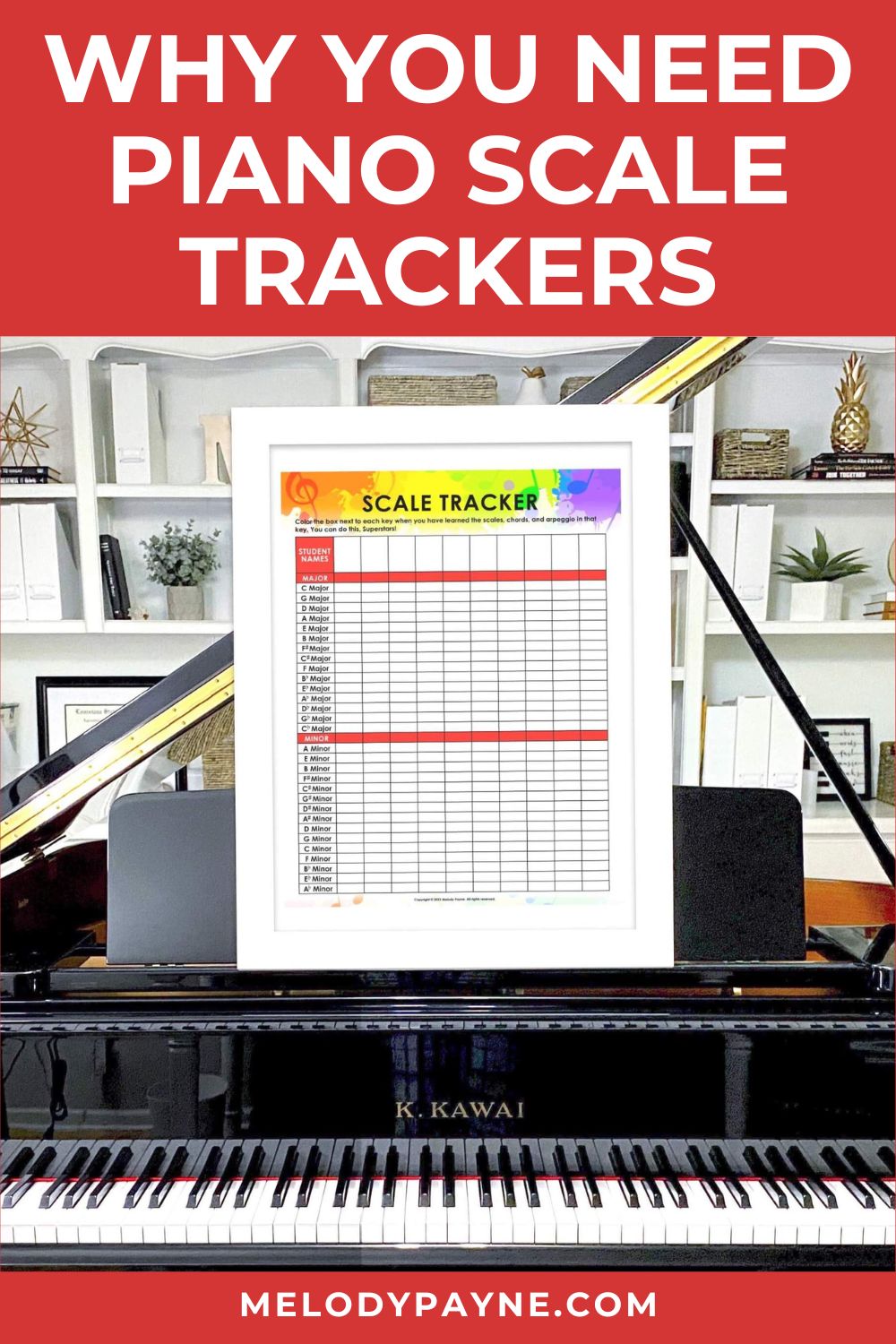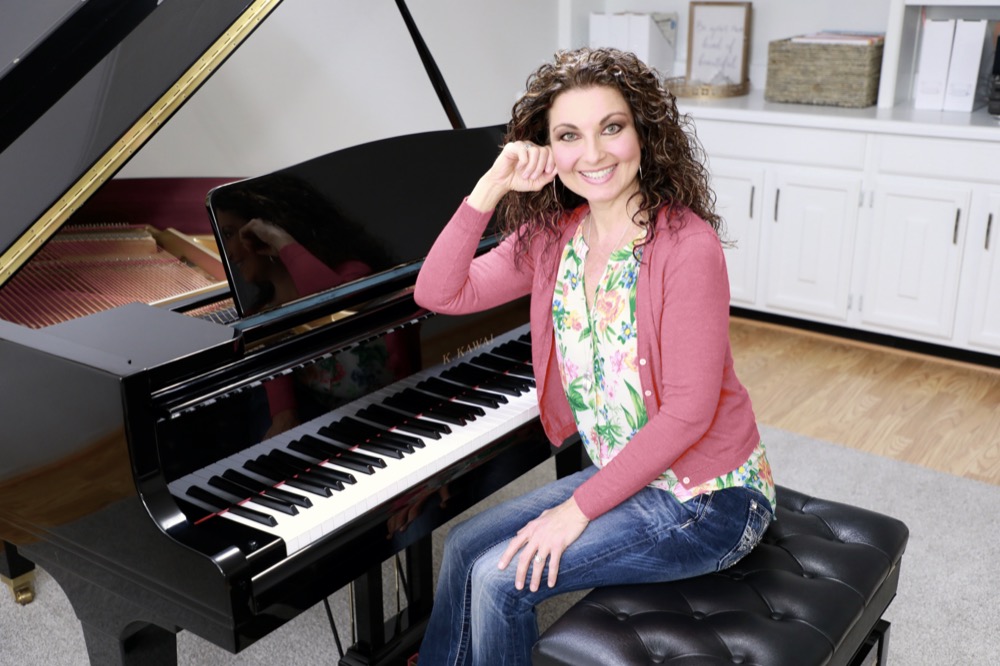3 Reasons You Need Piano Scale Trackers in Your Piano Studio
This post may contain affiliate links. If you purchase something through an affiliate link, I will receive a small commission at no cost to you. For more information, read the disclosure statement here.

If your students are bored with playing their technique, you’ll be very excited to see recently published major and minor piano scale trackers in Melody Payne’s arsenal of useful piano teacher resources.
In this blog post, you’ll read three reasons why you need these fantastic piano scale trackers.
Before I outline my ideas, here’s what you’ll receive when you purchase this very affordable instant download:
- Professionally designed, colorful charts that track either 10, 20, or 30 students per page
- 8.5 x 11 inch or 17 x 22 inch poster-sized charts for you to print out at home
- A step-by-step video tutorial if you need help printing and assembling the large poster
- All the major and minor keys on 1 chart
- Opportunities galore for you to encourage and inspire your music students to work on their technique this year!
And now, here are my three reasons music teachers of all kinds need these piano scale trackers.
1. These Piano Scale Trackers are Versatile
Scales and other technique had been on my mind as I prepared for fall start-up. What could I do to get students excited about practicing their technique?
My studio needed a major shake-up when it came to teaching new technique and reviewing technique that had already been taught.
I do hold a special “Piano Technique Olympics” every year in March, but that’s a long way off.
Right out of the starting block in September, I felt that my students needed something to kick-start their technique development and keep it going strong throughout the teaching year.
Enter these major and minor piano scale trackers developed by Melody Payne. Their versatility will make you just as excited as I was to download your copies and put them into immediate use.
a. Use for exactly what you need it for
The instructions say, “Color the box next to each key when you have learned the scales, chords, and arpeggio in that key. You can do this, Superstars!”
However, you, the teacher, decide if your students need to learn everything in that key or just the scales, or just the chords, or just the arpeggios.
For example, in my studio, students range from age five to adult, and from beginners to advanced.
I’ll likely just require my littles to play the scales in some of the listed keys, whereas older and more advanced students will be expected to add the chords and arpeggios.
b. Use piano scale trackers for in-person or virtual piano lessons
You can display the large piano scale tracker poster in your studio for all to see, or print out the 8.5 x 11 charts (standard US letter page size) to put in your teacher binder so you can see at a glance how each student is doing. This will aid in your lesson planning.
Or, don’t print anything at all! Use the charts digitally on your iPad. Whichever way you choose to use them, these scale trackers will help in your organization this year.
c. Use these scale trackers for more than piano!
These scale trackers are not just for piano teachers! They are useful for band, orchestra, or any instrumental teacher, really. All music students need to learn their scales, don’t they?

2. These Piano Scale Trackers Co-Ordinate With the Superstar Scales, Chords, and Arpeggio Series
Did you happen to see the amazing Superstar Scales, Chords, and Arpeggio books that have recently been published by Melody Payne?
In-depth blog posst have already been written about them, so I won’t go into detail here. You can catch up on all the Superstar Scales blog posts by reading:
- Teaching Beginning Piano Technique To Young Piano Students (for 5-finger pentascales with helper notes and accidentals)
- 5 Reasons To Use Junior Superstar Scales With Young Beginners (for 5-finger pentascales with key signatures, no helper notes)
- Teaching Scales, Chords, And Arpeggios Using The Superstar Scales Piano Technique Book (for 1-octave piano scales, chords, and arpeggios)
- 13 Fail-Proof Ways to Teach 2 Octave Piano Scales & Chords (for 2-octave piano scales, chords, and arpeggios)
However, I don’t want you to miss out on the opportunity to own both the technique books and the matching piano scale trackers, so briefly, here’s a synopsis of the Superstar Scales books:
- There are four books in the series, from beginning level to more advanced.
- You can print them out in black & white or color, your choice, but either way, the design co-ordinates with the piano scale trackers for a uniform look.
- You can print and bind the pages to make your students a special book of technique, or you can print, three hole punch, and put the pages in a binder.
- Or, you can use these piano technique books digitally — save your ink altogether!
If you already own one or more of these technique books, you know how useful they are. If not, what are you waiting for?
These clear, easy-to-follow technique books and coordinating scale trackers are sure to make your students more excited about learning their technique than ever!
3. Piano Scale Trackers Showcase Your Students’ Progress
If you choose to print out the large, poster-sized piano scale tracker (all it takes is 4 sheets of card stock) and display it on your studio or classroom wall, then parents, visitors, and students will be able to see the progress that has been made in your studio.
Of course, progress in technique isn’t the only thing that is happening in your studio, but it’s one aspect that often gets neglected. I’m guilty of this sometimes.
However, having an attractive chart proudly displayed in the studio is a visual reminder to everyone, teacher included, that technique is something that needs to be consistently learned and reviewed.
Once learned, students’ accomplishments in this area should be celebrated.
Encourage your students to focus on their technique, and point out their progress as they color in segments of the scale tracker chart week by week.
Their hard work and achievements will be seen by all, and having the chart hanging in a very visible place in your studio or classroom may promote some friendly competition amongst your students!
What other uses can you think of for these beautiful, professional, easy to use piano scale trackers? Let us know in the comments below!
Grab your major and minor piano scale trackers here today and solve the problem of student boredom with their technique!
Keep reading more blog posts for fun piano technique practice & more…
Don't miss out!
Follow on Facebook and Instagram, join the best Facebook group for piano teachers, and subscribe to the newsletter to get helpful teaching tips, resources, and tutorials delivered straight to your inbox every week.
Celeste-tina Hernandez
Celeste-tina Hernandez
Welcome!

Hi! I’m Melody Payne, a pianist and piano teacher, educational resource author, a fun-loving wife to the most wonderful and talented hubby I could ask for, and a lifelong learner who loves to share. I want to make your life as a music teacher easier by writing and sharing helpful and relevant music teaching articles, and by creating educational resources with your very own students in mind. If you are a parent who wants to enroll your child in piano lessons, I’d love for us to get started building those skills that can give your child a lifetime of musical enjoyment!

